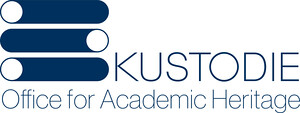Office for Academic Heritage, Scientific and Art Collections
01062 Dresden
Germany
Between science, art and history
The Office for Academic Heritage (Kustodie) at TU Dresden holds, in addition to the university’s 40 teaching and research collections in the fields of natural sciences and engineering, an outstanding inventory of art works. This collection has grown since 1951 to include nearly five thousand pieces today.
Established in 1979, the Kustodie is one of the oldest of its kind in Germany. Among its exceptional collections is the historic dye collection, which, with more than twenty-five thousand synthetic and natural dye samples, reflects the color spectrum beginning in the 1830s; the significant collection of acoustic-phonetic devices; and the unique photographic teaching collection of the photo-pioneer Hermann Krone from the 19th century. The natural history collections, such as the Herbarium Dresdense are still important resources for current research projects.
It is unique in its precocious intertwining of technical-scientific collections with collaborative commissions and acquisitions for the university’s art collection. The latter is exemplary for art of the GDR and, with its focus on abstract art of the early 1950s, inhabits a special place among collecting institutions in East Germany. One example of this is the 1957 architecture-bound creation by Hermann Glöckner in the physics building (Recknagel building) of TU Dresden. For the art collection, art-on-architecture commissions have played a significant role for centuries, transcending all political systems. Since 2016 the art collection has been – sometimes in cooperation with the Institute for Art and Music at TU Dresden—developed systematically and scientifically and has been presented to a wider public through general exhibitions.
The Kustodie would like to establish the university’s collections as a symbol of scholarly and scientific practice, to make it a fruitful source of academic history, to question it discursively within the framework of current research topics and, with educational methods, to open it up to the public at large. At the same time, it aims to activate the various material cultures in the scientific collection for artistic research.
The Kustodie’s multi-faceted exhibition activities include a permanent exhibition that displays a cross section of the scientific-technical collections at the university as well as items relating to the university’s history. In parallel, it presents special exhibitions on the interfaces between contemporary art, science and research, initiates Art Science Labs and offers residencies for artists as part of the Schaufler Lab@TU Dresden. In the context of these platforms, the Kustodie invites internationally known contemporary artists such as Asad Raza, Rosa Barba, Christian Kosmas Mayer, Bettina Allamoda, Anton Ginzburg, Olaf Holzapfel and Esmeralda Conde Ruiz to TU Dresden to explore—working closely with scholars and scientists at the university—the pressing questions of the moment and artistic approaches to research: from artificial intelligence to smart materials to topics related to environmental science.
On the potential of collaborative practice between art and science, the artists Asad Raza and Bettina Allamoda emphasize the following:
“My artistic projects involve many actors; collaboration with scientists is central to them. At the Kustodie of TU Dresden, I was also able to include their teaching and research collections in my process, taking advantage of their cross-disciplinary and future-oriented network of object cultures and knowledge systems.” (Asad Raza 2022)
“For me, the residency at the Kustodie and at the Institute of Lightweight Engineering and Polymer Technology at TU Dresden was an opportunity to experiment with new materials like glass and carbon fibers and to further develop my installations under new material and aesthetic conditions, in cooperation with lightweight engineers. Thinking in new ways, processing and ‘inventing’ innovative materials is an expansion of my artistic practice in the form of an experimental inquiry into the interactions between technology and art.” (Bettina Allamoda 2019/20)
These process-centered formats are presented in the University´s Art Gallery in the Goerges building at TU Dresden as well as in other exhibitions spaces in the city.
The Kustodie is part of a worldwide network of university collections and museums. In 2024, in cooperation with ICOM UMAC and UNIVERSEUM, the Kustodie is hosting the first joint conference of university collections in Dresden. The focus of the program is natural science and engineering collections and their significance for future inquiry and technology as well as the role of artistic research and artist residencies in university collections.
*Images above: [1] With works by Bettina Allamoda, Johannes Makolies, Bignia Wehrli and Adrian Sauer. [2] Recknagel building, TU Dresden, Art Collection of TU Dresden. [3] View of TU Dresden`s Rectorate, art work by Petra Kasten and Preparation of a Carp Skeleton Cyprinus carpio L., Zoological Teaching Collection, 2021. [4] Historical Acoustic-Phonetic Collection. [5] Opened collection cabinet of the dye collection. [6] André Tempel and other artists. [7] With Asad Raza´s work Root sequence. Mother tongue. [8] Part of A & I - The Schaufler Residencies@TU Dresden 2020 & 2021.









